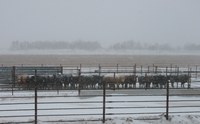Protect Cattle From Winter Weather
(Click the image below to view a high-resolution image that can be downloaded)
Winter on the northern Great Plains is a harsh environment for beef cattle.
During the winter, cattle increase their production of body heat in response to severe cold by increasing their heart rate, respiration and blood flow. This physiological response may result in lower gains and reduced feed efficiency, even with increased feed intake.
“That’s why good winter cattle management practices are so important,” says Vern Anderson, animal scientist at North Dakota State University’s Carrington Research Extension Center. “These practices contribute to healthy, productive cattle and reasonable feed costs.”
Here are ways to mitigate the effects of winter on beef cow and feedlot cattle:
- Cattle adapt to cold during a period of time. Provide adequate, good-quantity feed so animals can gain weight prior to severe weather if at all possible. Fat reserves are insulation and will provide extra energy during severe cold when feed may not meet the animals’ energy requirements.
- Wean calves before severe cold to reduce the cows’ nutritional requirements and allow cows to gain condition. Wean calves a few weeks before severe weather arrives if possible. This gives the calves time to adapt to new rations and gain weight and condition prior to winter weather.
- Protect cattle from the wind. A combination of constructed wind fences and shelterbelts with mature trees is ideal. Wind fences can be constructed of wood, metal, bales, tires or other materials. For more information on wind fence construction, see the “Beef Housing and Equipment Handbook” available from MidWest Plan Service at http://www.mwps.org.
- Provide feedlot cattle with bedding. Frequent bedding with modest amounts will keep feedlot cattle and replacement heifer dry and clean, which significantly improves gains and feed efficiency. Bed cows prior to and during calving. Cereal grain straw is preferable, but corn stover is acceptable.
- Keep feed bunks reasonably clear of snow, especially for feedlot cattle. If cows are fed on the ground, feed on a new or clean area every day to disperse manure and reduce potential health issues.
- Offer better-quality forage in cow rations during severe cold to help compensate for increased energy needs. Cold temperatures increase appetites, which increases the rate of passage through the digestive system, causing a decrease in feed’s digestibility. Provide supplemental feed, such as coproduct feeds, for energy and/or protein if feeding low-quality forages.
- Avoid feeding very high-moisture rations because these feeds can freeze in the feed bunk, and intake may be reduced. Frozen feed takes more energy to thaw and digest.
- Sort cows by nutrient requirements and feed them according to need to optimize feed use. Sorting can reduce overfeeding of some animals and allow thin cows to gain weight.
- Feed cattle late in the day during severe cold. The activity involved in eating and ruminating will increase the animals’ heat production during the night. Feeding late in the day during calving may increase the number of calves born during daylight hours.
- Make sure animals have adequate amounts of clean, fresh water at all times. Water does not have to be warm.
- Be prepared for winter storms. Have snow removal equipment ready and in good repair. A backup generator may be advisable in case of power outages to maintain water pressure and heat sources, and run equipment to process feeds. Identify extra workers who can help during emergency situations. Remove snow from pens, especially in areas adjacent to feed bunks and water fountains, as time permits.
- Feeding animals inside a closed building isn’t advisable unless ventilation is adequate and knowledgeable management, labor and bedding are provided. Ammonia concentrations from poorly ventilated structures can cause major air quality problems. High humidity and crowding can reduce the insulating ability of an animal’s hair coat significantly. Diseases transmit more readily in humid, crowded buildings.
- Sort cows close to calving into more accessible pens so you can observe the animals and address any problems more easily.
- Enclose cattle trucks when shipping animals in severely cold weather.
- Make sure hospital pens and receiving pens for newly arrived calves are especially well-protected from the effects of winter weather.
For more information on helping cattle survive winter weather, visit two new NDSU publications: “Winter Management of Feedlot Cattle,” at http://www.ag.ndsu.edu/pubs/ansci/beef/as1546.pdf, and “Winter Management of the Beef Cow Herd,” at http://www.ag.ndsu.edu/pubs/ansci/beef/as1564.pdf.
NDSU Agriculture Communication - Sept. 30, 2011
| Source: | Vern Anderson, (701) 652-2951, vern.anderson@ndsu.edu |
|---|---|
| Editor: | Ellen Crawford, (701) 231-5391, ellen.crawford@ndsu.edu |


